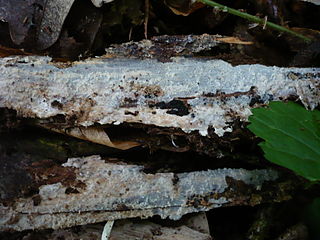
Agaricomycetidae is a subclass of fungi, in the division Basidiomycota. The name Agaricomycetidae had previously been named by Marcel Locquin in 1984, but his publication did not contain a Latin diagnosis and it is therefore invalid under the International Code of Nomenclature for algae, fungi, and plants. It was subsequently validly published by Erast Parmasto in 1986.
Phanerochaete carnosa is a species of crust fungus in the family Phanerochaetaceae. It is a plant pathogen that infects plane trees. The fungus was first described to science by Edward Angus Burt in 1926 as a species of Peniophora. It was transferred to the genus Phanerochaete by Erast Parmasto in 1967.

Phanerochaete is a genus of crust fungi in the family Phanerochaetaceae.

The Meruliaceae are a family of fungi in the order Polyporales. According to a 2008 estimate, the family contains 47 genera and 420 species. As of April 2018, Index Fungorum accepts 645 species in the family.

The Phanerochaetaceae are a family of mostly crust fungi in the order Polyporales.

Erast Parmasto was a noted Estonian mycologist, bioscientist and botanist and onetime director of the Estonian Institute of Zoology and Botany.
The Estonian Institute of Zoology and Botany (ZBI) was a zoological and botanical research institute based in Tartu, Estonia. It was founded in 1947. Since 1997, it belonged to the Estonian University of Life Sciences as a central biological research institute in the country. On January 1, 2005 it was merged into the Institute of Agricultural and Environmental Sciences.

The Botryobasidiaceae are a family of fungi in the order Cantharellales. The family contains a group of corticioid fungi that form thin, web-like basidiocarps. Some species form asexual anamorphs producing chlamydospores. All are believed to be wood-rotting or litter-rotting saprotrophs. None is known to be of any economic importance.

Byssomerulius is a widely distributed genus of crust fungi.

Resinicium is a genus of crust fungi of uncertain placement in the class Agaricomycetes. The genus was circumscribed by Estonian mycologist Erast Parmasto in 1968.

Phlebia is a genus of mostly crust fungi in the family Meruliaceae. The genus has a widespread distribution. Phlebia species cause white rot.

Mycoacia is a genus of toothed crust fungi in the family Meruliaceae. It was circumscribed by Dutch mycologist Marinus Anton Donk in 1931.
Hydnomerulius pinastri is a fungal species of the monotypic genus Hydnomerulius within the Paxillaceae family. H. pinastri is a saprophyte whose nutritional mode creates a brown rot through H2O2 decay of cellulose and hemi-cellulose. This species has not been thoroughly studied outside of taxonomic attempts to place it within the fungal tree. As such, its ecological role beyond as a wood decaying agent is unclear at this time. H. pinastri may be referred to colloquially as "spiny dry rot" or "spiny dry rot fungus".

Hydnophlebia is a genus of five species of toothed crust fungi in the family Meruliaceae. All species are wood-decay fungi that cause a white rot.

Hypochnicium is a genus of corticioid fungi in the family Meruliaceae. The genus was circumscribed by mycologist John Eriksson in 1958.

Liiva-Putla Nature Reserve is a nature reserve situated on Saaremaa island in western Estonia, in Saare County.

Leucogyrophana mollusca is a fungus of the genus Leucogyrophana and family Hygrophoropsidaceae.

Byssomerulius corium is a common species of crust fungus in the family Irpicaceae. The fungus was first described as Thelephora corium by Christiaan Hendrik Persoon in 1801. Erast Parmasto made it the type species of his newly circumscribed genus Byssomerulius in 1967.

The Irpicaceae are a family of mostly polypores and crust fungi in the order Polyporales.
Acanthophysellum is a genus of fungus belonging to the family Stereaceae.













